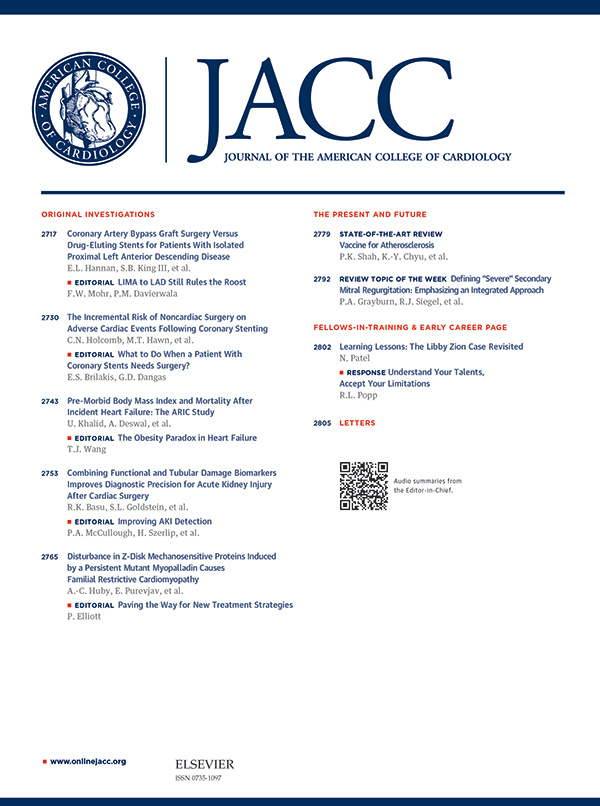早期主动脉内球囊支持治疗心力衰竭相关心源性休克:一项随机临床试验
IF 21.7
1区 医学
Q1 CARDIAC & CARDIOVASCULAR SYSTEMS
引用次数: 0
摘要
主动脉内球囊泵(IABP)对心力衰竭-心源性休克(HF-CS)患者的生存和成功桥接心脏替代治疗(HRT)的影响尚不清楚。本研究的目的是评估早期使用IABP与标准治疗对60天生存率或成功过渡到HRT的影响。方法在多中心前瞻性Altshock-2(急性失代偿性心力衰竭并发心源性休克的早期主动脉内球囊泵放置研究)中,心血管血管造影与干预学会B、C或D期HF-CS患者随机分为早期IABP加标准治疗组(IABP组)或标准治疗组(对照组)。主要终点是生存或60天成功过渡到HRT。次要终点包括总生存期、最大肌力评分和最大序贯器官衰竭评估评分。结果53例患者随机分为IABP组,48例患者随机分为标准治疗组。患者分别为心血管血管造影与干预学会B期(28%,n = 28)、C期(57%,n = 56)和D期(15%,n = 16)。在预先规定的中期分析中,试验因无效而停止。IABP组43例(81%)患者达到主要终点,对照组36例(75%)患者达到主要终点(HR: 0.72;95% ci: 0.31-1.68;p = 0.45)。在60天的随访中,共有37名患者(37%)接受了激素替代疗法。研究组4例(7.5%),对照组2例(4.2%)。此外,6例(13%)最初接受标准治疗的患者转为IABP治疗。两组间并发症具有可比性。结论:与标准治疗相比,常规早期IABP加标准治疗并没有显著提高HF-CS患者的生存率或成功过渡到HRT。急性失代偿性心力衰竭并发心源性休克早期主动脉内球囊泵置入的研究[Altshock-2];NCT04369573)本文章由计算机程序翻译,如有差异,请以英文原文为准。

Early Intra-Aortic Balloon Support for Heart Failure-Related Cardiogenic Shock
Background
The impact of intra-aortic balloon pump (IABP) on survival and successful bridging to heart replacement therapies (HRT) in patients with heart failure–cardiogenic shock (HF-CS) remains unclear.
Objectives
The purpose of this study was to evaluate the effect of early IABP use vs standard care on 60-day survival or successful bridging to HRT.
Methods
In the multicenter, prospective Altshock-2 (Study on Early Intra-aortic Balloon Pump Placement in Acute Decompensated Heart Failure Complicated by Cardiogenic Shock), patients with Society for Cardiovascular Angiography and Interventions stage B, C, or D HF-CS and suitable for HRT were randomized to receive early IABP plus standard care (IABP group) or standard care (control group). The primary endpoint was survival or successful bridge to HRT at 60 days. Secondary endpoints included overall survival, maximum inotropic score, and maximum sequential organ failure assessment score.
Results
In total, 53 patients were randomized to IABP and 48 to standard care. Patients were Society for Cardiovascular Angiography and Interventions stage B (28%, n = 28), C (57%, n = 56), and D (15%, n = 16). At the prespecified interim analysis, the trial was stopped because of futility. The primary endpoint was reached in 43 patients (81%) in the IABP group and 36 patients (75%) in the control group (HR: 0.72; 95% CI: 0.31-1.68; P = 0.45). A total of 37 patients (37%) underwent HRT within the 60-day follow-up. Four patients were escalated in the study group (7.5%) vs 2 in the control group (4.2%). Additionally, 6 patients (13%) initially assigned to standard care crossed over to IABP. Complications were comparable between groups.
Conclusions
Routine early IABP plus standard care, compared with standard care, did not significantly improve survival or successful bridging to HRT in patients with HF-CS. (Study on Early Intra-aortic Balloon Pump Placement in Acute Decompensated Heart Failure Complicated by Cardiogenic Shock [Altshock-2]; NCT04369573)
求助全文
通过发布文献求助,成功后即可免费获取论文全文。
去求助
来源期刊
CiteScore
42.70
自引率
3.30%
发文量
5097
审稿时长
2-4 weeks
期刊介绍:
The Journal of the American College of Cardiology (JACC) publishes peer-reviewed articles highlighting all aspects of cardiovascular disease, including original clinical studies, experimental investigations with clear clinical relevance, state-of-the-art papers and viewpoints.
Content Profile:
-Original Investigations
-JACC State-of-the-Art Reviews
-JACC Review Topics of the Week
-Guidelines & Clinical Documents
-JACC Guideline Comparisons
-JACC Scientific Expert Panels
-Cardiovascular Medicine & Society
-Editorial Comments (accompanying every Original Investigation)
-Research Letters
-Fellows-in-Training/Early Career Professional Pages
-Editor’s Pages from the Editor-in-Chief or other invited thought leaders

 求助内容:
求助内容: 应助结果提醒方式:
应助结果提醒方式:


